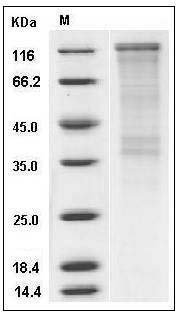-
Product Name
Human CDON (His Tag) recombinant protein
- Documents
-
Description
Cell adhesion molecule-related, down-regulated by oncogenes (CDON), also known as CDO, is an Ig superfamily member, is a component of a cell surface receptor that positively regulates skeletal myogenesis. Brother of CDO (BOC) is a cell surface receptor that derives its name from the structurally related protein, CDON. They are components of a cell surface receptor that positively regulates myogenesis in vitro. Expression of Cdo and Boc in myoblast cell lines is downregulated by the ras oncogene, and forced re-expression of either Cdo or Boc can override ras-induced inhibition of myogenic differentiation. CDO and BOC play a role in the inverse relationship between differentiation and transformation of cells in the skeletal muscle lineage. CDON binds to Bnip-2 and JLP, scaffold proteins for Cdc42 and p38alpha/beta MAPK, respectively. The Bnip-2/Cdc42 and JLP/p38alpha/beta complexes associate in a CDON-dependent manner, resulting in Bnip-2/Cdc42-dependent p38alpha/beta activation and stimulation of cell differentiation. It is proposed that CDO mediates, at least in part, the effects of cell-cell interactions between muscle precursors that are critical in myogenesis.
-
Protein short names
MGC129383; MGC111524; CDO; CD0; CDON; CDON1; HPE11; ORCAM
-
Source/Expression Host
Human Cells
-
Expression Plasmid/cDNA
A DNA sequence encoding the human CDON (AAI14436.1) extracellular domain (Met 1-Asp 963) was expressed, with a polyhistidine tag at the C-terminus.
-
Protein Species
Human
-
Molecular weight
The recombinant human CDON consists of 949 amino acids and has a calculated molecular mass of 103 kDa. It migrates as an approximately 125 kDa band in SDS-PAGE under reducing conditions.
-
Purity
> 65 % as determined by SDS-PAGE
-
Validations

Human CDON / CDO Protein (His Tag) SDS-PAGE
Related Products / Services
Please note: All products are "FOR RESEARCH USE ONLY AND ARE NOT INTENDED FOR DIAGNOSTIC OR THERAPEUTIC USE"
